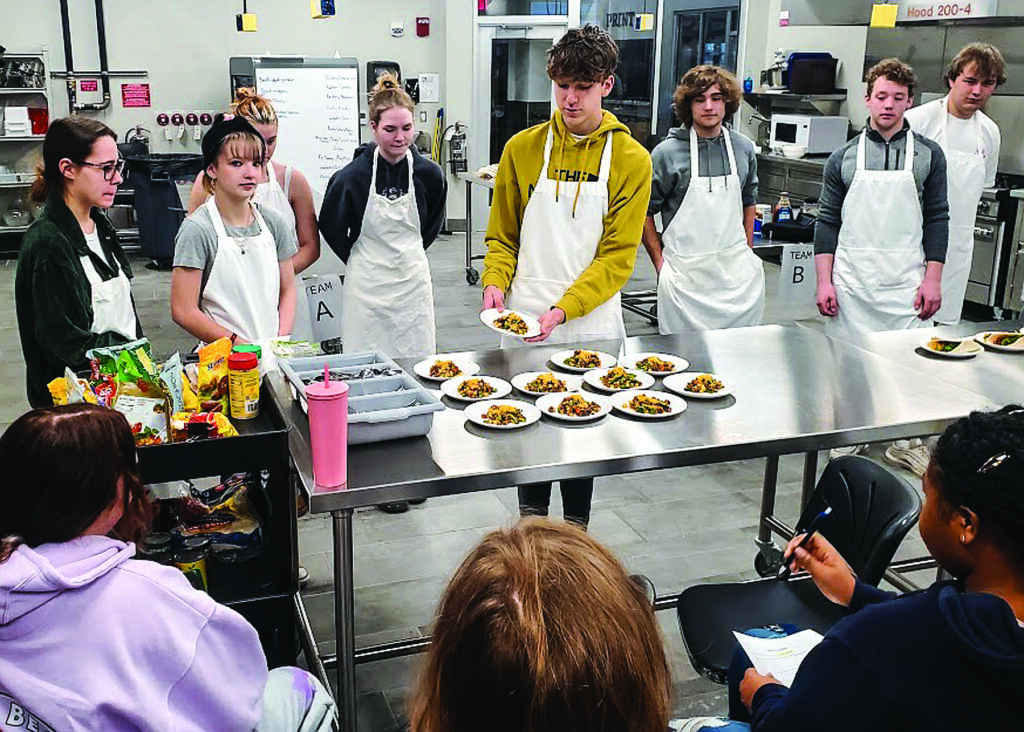
Culinary students show off their skills in a competition modeled on the TV show “Chopped,” using mystery ingredients including applesauce, sweetened condensed milk, canned potatoes, whole zucchini, frozen strawberries, cooked chicken breast, ground beef and banana chips
Nancy Edmonds Hanson
There was a time, not so long ago, when eateries’ ads sought to tantalize customers’ taste buds. Now, most are trying to whet the appetites of a different kind of audience in desperate demand — potential employees.
“Everybody is so hungry for workers,” says culinary instructor Johanna Heigaard. “Hopefully, we’re going to take a bite out of that.”
Johanna is the food service professional hired to create Moorhead High School’s first culinary arts offerings. Quartered in the MHS Career Academy, she has been teaching high school students the ins and outs of creating memorable meals since last fall, when 24 students inaugurated her first Culinary I class in the academy’s gleaming state-of-the-art industrial kitchen.
Since M State discontinued its long-standing culinary program several years ago, the F-M area has been without a center where aspiring chefs can hone their skills to take their places in the booming food service industry. The Career Academy is determined to change that, preparing teens to step right from graduation into jobs in an industry that’s ravenously hungry for help.
“It’s not just about becoming a chef,” Cheryl Adams observes. She chairs MHS’s Family and Consumer Science department, the area in which the pro culinary program rests as part of the Career Academy’s Farm to Table pathway. (Also included are classes in agriculture and natural resources.) “Students who choose this career can step right into a wide variety of jobs.” Among those she and Johanna cite: chefs in restaurants, catering, hotels, schools, hospitals, nursing facilities, industry and other settings; hospitality and food service management; food distribution corporations; product development in manufacturing companies; and ag commodities groups.
“You’re not just gong to be in the kitchen making sandwiches,” Johanna smiles. “You could be running the whole show.”
What’s destined to be a two-year program has just begun to take shape. Johanna, a native of Park River, North Dakota, and 2008 graduate of M State, has been dividing her time between teaching the initial one-semester culinary course and developing more robust plans for the year-long Culinary I and II classes that will debut in Fall 2023; registration is open now for those who plan to enroll in next year.
In this initial season, Johanna’s students have gotten an overview of the industry that many, perhaps most, aspire to enter. Meeting for one 85-minute block per day in the Academy’s commercial kitchen, their first lessons focus on ServSafe, the all-important industry standard of food safety and sanitation. They have mastered knife skills. They have been introduced to “mis en place,” the technique chefs use to assemble meals quickly and near-effortlessly with ingredients measured, cut, peeled, and sliced and their pans, mixing bowls and tools at the ready. They have learned about flavor profiles, about rescuing recipes gone wrong, about plating to please diners’ eyes as well as their stomachs, and muchmore.
One popular exercise, Johanna says, is her version of the TV cooking show “Chopped.” Teams compete to create fine food from a basket of mystery ingredients. One recent challenge included applesauce, sweetened condensed milk, canned potatoes, whole zucchini, frozen strawberries, cooked chicken breast, ground beef and banana chips.
After the winners are proclaimed? They sit down to taste what they’ve all come up with.
As with all classes grouped in the Career Academy’s six pathways, the fledgling culinary arts program is intended as a sampler, opening teens’ eyes to career possibilities they may never have considered. MHS encourages all its students to try their hands at some of its vast range of professions, from business and entrepreneurship, information technology, manufacturing and the trades to the liberal arts and health care. Some courses arestructured as one-semester or even nine-week experiences. Others, like this one, are built on a longer and more comprehensive model, designed to prepare successful students to get a head start in the post-graduation job market.
Johanna plans to bring industry professionals into her enviably equipped classroom to talk about the realities of lives spent in culinary careers. She and Cheryl also foresee internships as the capstone to Culinary II. “We want to let the kids see this industry isn’t just about cooking,” she says. “When they meet professionals in the field, we hope that they’ll get excited about all the facets and all the possibilities that are waiting for them.”
So far, the excitement level looks promising. When she surveyed the young men and women who completed her first initial culinary course before Christmas, she says, “100% of them would like to sign up for Culinary II.”
And whether or not they eventually choose careers in the industry, Cheryl beams with pride at what they’re already taking away. “We’re very proud that they’re coming out with this knowledge and these skills. They’re going to use them every day for the rest of their lives. Whether they’re cooking for thousands or just feeding themselves, it’s a win. Everybody needs to eat!”


